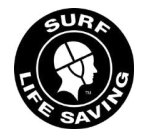(a) The team members that have drawn the relevant numbers shall contest this component of the event. The numbers are:
(i) Open Team: No’s 3, 5 and 6
(ii) U/17 Team: No’s 1, 2 and 3
(b) The course shall be set as per the Rescue Tube Event (refer Section 4 – Swimming Events):
(i) The two green flags shall indicate the start/finish line
(ii) The rescue tube (and swim fins, if used) shall be placed on a line approximately 10m from the start line. Competitors may lay the rescue tube to suit themselves provided that the tube is placed flat on the sand, and that the rope or belt harness shall not extend on the seaward side of the tube. The competitors will then take up their positions on the seaward side of the starting line. The swim fins (if used) are to be placed with the rescue tubes at the competitor’s discretion.
(iii) If the option not to use swim fins is taken the swim fins are not required to be placed with the rescue tube.
(c) Each patient shall take up their position on the start line in the allotted position.
(d) On the starting signal, each patient shall enter the water and swim to their allotted buoy. On reaching their allotted buoy, the patient shall place their forearm over the top of the buoy and then signal their arrival by raising their other arm to a vertical position whilst remaining in contact with the buoy. The said signal, subject to all conditions being fulfilled, shall be the determining factor in judging the patient’s arrival at their buoy. Should a competitor swim to a wrong buoy and signal the team shall be disqualified. The patients must then release contact with the swimming buoys, retire to the seaward side of the swimming buoys and await arrival of their rescuer.
Note: The swimming buoy is described as the buoy only and does not include any attaching ropes or straps.
(e) In the interim each rescue tube swimmer shall take up their position on the starting line in the allotted position and await the arrival signal from the patient.
(f) On receiving the patient’s signal the rescue tube swimmer shall race up the beach and take hold of the rescue tube and swim fins (if used). They shall don the rescue tube and swim fins (if used) at their own discretion and swim to their allotted buoy.
(g) On reaching their allotted buoy, the rescue tube swimmer shall place their forearm over the top of the buoy and then signal their arrival by raising their other arm to a vertical position whilst remaining in contact with the buoy. The said signal, subject to all conditions being fulfilled, shall be the determining factor in judging the rescue swimmer’s arrival at their buoy. Should a competitor swim to an incorrect buoy and signal the team shall be disqualified. The rescue tube swimmers must then release contact with the swimming buoys, retire to the seaward side of the swimming buoys with their patient and await arrival of their board rescuer.
Note: The swimming buoy is described as the buoy only and does not include any attaching ropes or straps.
(h) Each board rescuer shall take up the allotted position with their board on the starting line, to await the signal from the rescue tube swimmer.
(i) On receiving the signal the board rescuer shall enter the water and paddle to and around the allotted buoy. The board rescuer shall turn the buoy from left to right unless otherwise directed by the Referee. Each patient shall make contact with any part of the board on the seaward side of the swimming buoy. The patient pick up shall be affected on the seaward side of the buoy. The patient may position themselves on the front or rear of the board, with or without assistance and may assist the rescuer by paddling the board on the return to shore.
Note: A team shall not be disqualified if part of the board extends onto the shoreward side of the buoy during the patient pick up process.
(j) Losing control of patient and/or board – the board rescuer may lose control/contact and then regain control of the board on the way to their turning buoy. The rescuer and patient may lose contact with the board on the return journey. However, both the rescuer and patient must be in contact with the board when crossing the finish line.
(k) The finish is judged on the chest of the first competitor of the team (i.e. patient or rescuer) crossing the start/finish line on their feet, with both the rescuer and patient being in control and in contact with the board.
(l) The rescue tube swimmer then returns back to the beach and, as such, is not regarded as having any further part of the board rescue section of the event.
(m) Total points allocated to each team in Board/Tube Rescue Relay component is as follows:
Finish Position Points
1st – 10
2nd – 9
3rd – 8
4th – 7
5th – 6
6th – 5
7th – 4
8th – 3
9th – 2

